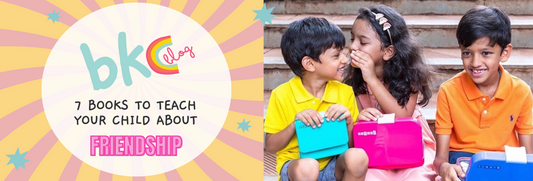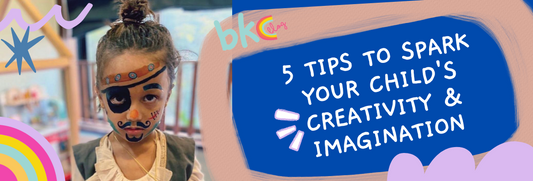Young children are innately curious, and that curiosity fuels their creativity and imagination. But like anything else, creativity needs to be nurtured and practised, especially as your child grows older. Independent imagination and creative thinking are essential assets for your child to succeed. Here are some research-backed methods to nurture your child’s imagination.

Observe your young child – toddler or preschooler – when they play independently. When you hand them a new toy, you would probably see them turn the toy over in their hands and examine every detail before deciding whether they like it or not. Eventually, they may settle into the quietness of their thoughts or their own chatter. These expressed behaviours guide your child’s curiosity in this scenario.
According to Harvard researcher Elizabeth Bonawitz, a human being’s natural physiological response to information is curiosity. It’s a filter that helps the mind decide what information to pick. Curiosity, when stimulated the right way, sparks creativity and nurtures imagination.
As you read on, we will discuss the benefits of being curious, how parents can spark creativity in children, and how books are the perfect vehicles to nurture imagination.
Why Is It Important to Be Curious?
Every child is born curious; it is how they learn about the world. Till they are of a certain age, they depend on their primary caregivers to pick information and understand the ways of the world around them. As they grow older and learn to be mobile, their inquisitive nature starts becoming overt. Mouthing everything and crawling to the nooks and crannies of your home are two instances of their curiosity.
Believe it or not, curiosity is critical for child development. Here’s how:
-
Being eager to explore a child’s surroundings helps them improve their motor skills.
-
Your child picks up social skills and etiquettes. Your child will likely observe what you are doing when they have to do something new – like using cutlery properly.
-
Curiosity helps your child be a better listener. This helps improve language skills.
-
A child is equipped to find solutions to everyday problems in their lives just by being curious. Next time your young child asks “What?”, “Why?”, or “How?”, remember that they are just curious.
-
Being curious helps your child be empathetic and kind. It helps start conversations around difficult concepts – such as race and discrimination – at a fairly early age.
-
Curiosity improves creativity and imagination. This helps them visualise plots in books or create fantasy landscapes when playing.
How to Nourish Creativity & Imagination
Now that we agree that nurturing your child’s curiosity is necessary for their creativity and imagination to thrive, let’s get into some ways you can support your child’s on their creative journey.
1. Encourage Unstructured Outdoor Play
Time to throw the rules out the window! Unstructured outdoor play is all about letting your kids explore, create and discover the world outside on their own terms – without any preset guidelines or goals. Not only does this sort of activity foster cognitive, physical, social, and emotional development, it specifically builds creativity, imagination, and problem-solving skills.
What’s more, unstructured outdoor play takes the pressure off you as well as your child – a win-win all around. Here’s how you can go about it:
-
Take your kid to any safe outdoor place – this could be your garden or backyard, or a park in your neighbourhood.
-
Allow them to explore as they wish and make props out of the things they find – leaves, sticks, sand, water, and even mud! Let your kid reimagine these objects in whatever way they please. Perhaps they’ll use them to create art, make a literal “mud cake”, or go on a “treasure” hunt. The possibilities are endless.
-
Do fight the urge to control the activity; but there’s no harm in providing some prompts for your child’s imaginative play. For instance, you could make a pretend hut or boat for ants with leaves and twigs to get your little one’s imagination going.
2. Say Yes to Boredom
If there’s one sentence that any parent dreads hearing, it’s “Mom, Dad… I'm bored!”. Here’s something that might make you feel a bit better next time you hear it – being bored is, in fact, great for your kid. Studies have shown that boredom encourages creativity and problem-solving skills. So don’t feel pressurised to organise an outing or an activity every time your kid complains of boredom. Allow them to sit with the feeling and use their imaginative thinking to find solutions for it.
3. Cut Down Screen Time
You know this one already, but we’ll put it out there anyway. Not only can excessive screen time cause obesity, behavioural issues, and impair academic performance, it has a negative impact on children’s imaginations as well. So monitor how much time your child is spending in front of a screen – be it the TV, tablet or mobile (it might just add up to more than you had thought!). Set the right example by reducing your own screen time as much as possible. Also discourage eating in front of a screen, and make sure to keep screens out of the bedroom.
4. Inspire Open-Ended Play
Cut back on toys that your child doesn't have much scope to contribute to. For instance, something that lights up and spins on the ground. Your child can chase it around perhaps, but not much else. Instead offer open-ended toys that encourage creative problem-solving and independent thinking, like building blocks, puzzles, or clay modelling.
A great way to improve writing skills, you can stimulate your child’s imagination with writing prompts that will present a hint of a scenario but not much else. It will be up to your child to build a world of their own.
If your child is more inclined towards artistic expression, then try art-related prompts. Provide them an empty canvas, some watercolour gel crayons (or these easy-to-use paint sticks) and paint-brushes. Then lead them with a playful prompt such as, what would it look like if you combine your two favourite animals to create a new species? Or, draw the house of your dreams; would you like it to have a chimney, a tower, or perhaps a slippery slide? The possibilities are endless!
5. Engage in Pretend Play
It’s obvious that pretend play boosts creativity and imagination – but it’s great for developing social, emotional, communication, and problem-solving abilities as well. Here are some different approaches to pretend play with your kid:
-
You know your little one best, so suggest scenarios that you know your kid will enjoy. Perhaps they’d like to go on a space adventure? Or maybe a jungle safari? Provide simple props from your wardrobe or around the house so your kid can dress up the part, or treat them with a fun face painting session (this book has some great ideas!). Save large cartons and keep some old sheets handy for setting up a tent, a fort, or whatever strikes your child’s fancy.
-
Another great way to encourage pretend play is with puppets. Make your own with some old socks, store-bought googly eyes, and a marker. You can use other odds and ends like buttons and bows to give the puppets more personality. Once the puppets are ready, it’s time to bring some imaginative stories to life!
-
Pretend play can happen sans props and DIY as well. Simply sit in a circle and have each person take turns to contribute one sentence towards building a story. The narrative will take lots of unpredictable twists and turns, sure to keep everyone entertained.
How Books Nurture Imagination
Your child will be bombarded with visuals from a young age – that’s just an inescapable truth. The more time we spend watching visuals, the less space we have for novel ideas. Books, on the other hand, challenge the mind in some very specific ways. Even if they have brightly coloured illustrations, they require us to actively use our minds to interpret the words on the page.
For children below the age of five, we recommend Harold and the Purple Crayon as a way to teach your young child about the power of their imagination. If your kid loves to playact, then Convertible Princess Carriage would provide fertile ground for them to make up their own stories and characters.
As your child grows older and their vocabulary starts expanding, the potential only grows. For your four-year-old, you must pick up a copy of Leaky Beak. This beautifully illustrated book teaches problem-solving and communications skills, while also providing ample opportunities for storytelling and reenactment. One little book, and many hours of fun!
Great for ages four and up are the books There's A Leopard In My House and One More Does Matter Lana. Both these environmentally themed books will educate your child, while encouraging them to ask questions and learn about the larger world beyond their own. Also, perfect for this age group are Try Your Best Patrick and Grown Ups Who Never Stopped Drawing to teach your child to value and nurture what makes them unique, instead hiding them to fit in with the crowd.

Encourage your child to explore the world through touch and play with Paperkraft Kits: DIY Mini Mandril, DIY Mini Red Panda, and DIY Mini Arabian Oryx. Once done, they will have an entire zoo of animals to play with.
As your child starts venturing into the world, they will feel the pressure to conform to how most people think. But if from a young age, they are encouraged to think for themselves and revel in their uniqueness, they will have the confidence to explore their creativity and ideas as adults. The way to success in a world of endless possibilities is innovation, and the way to cultivate an innovative mind is to have a rich imagination and the ability to channel it.





